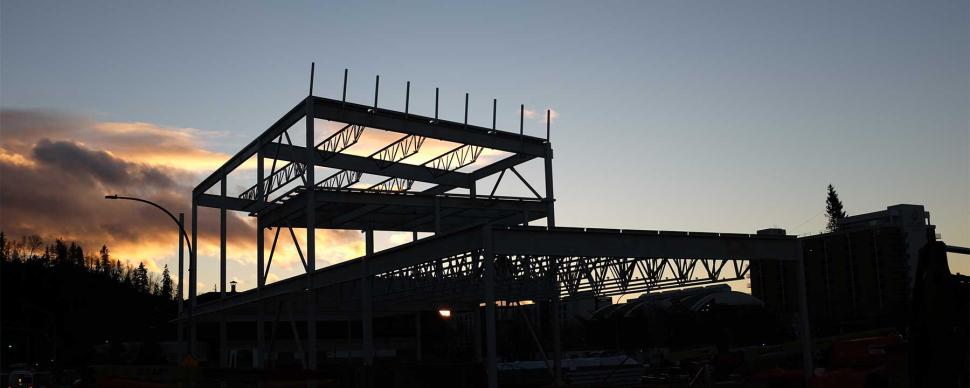1. What is infrastructure and why is it a big deal in Prince George?
Local governments spend more on "infrastructure" than anything else. It's a simple word that captures so much of what we use every day:
- Roads, bridges, street lights, and sidewalks.
- Water, sewer, and storm drainage.
- Arenas, pools, and other civic facilities.
- Parks, trails, and sports fields.
This page tells the story of Prince George's historical development and how the city's past relates to our local infrastructure.
While ageing infrastructure is an issue for every municipality, our population history, the city's geographic expansion, and the infrastructure that came with physical growth created conditions that are unique to Prince George.
2. From small town to big city
Prince George was incorporated in 1915, but its population stayed small until after World War II.
Starting in the 1950s, our city experienced a population boom and was considered one of the fastest growing cities in Canada. Much of our infrastructure dates from that period of rapid growth.
"The indications are that Prince George's growth (population tripled since 1915) has just been laying the foundation for its future" -- Financial Post in 1950
3. When we grew, what we predicted, and what actually happened
Our population increased rapidly after World War II. We went from 4,000 people in 1947 to 60,000 less than 30 years later.
From the 1940s to the 80s, the population doubled every decade. By 1981, Prince George was the seventh-largest city in British Columbia, and one of only two outside of Metro Vancouver.
Because of this experience, Prince George's first official community plan (1979) forecast a population of 185,000 by 2012. But growth began to slow in the 80s.
By 1996, the city's population peaked at just over 75,000. However, in recent years we are starting to grow again.

4. A brief history of Prince George's geographic expansion
In 1915, Prince George encompassed the current downtown and parts of the present-day Crescents and Millar Addition. The city's boundaries remained unchanged for nearly 40 years. In 1953, the first of 14 boundary expansions began.
Prince George grew from 5.1 square kilometres in 1915 to just slightly under 327 square kilometres by 1995. The city's land area grew by 6,309 per cent.
The single largest expansion came in 1975. The city grew to include Blackburn, College Heights, and the area north of the Nechako River.

5. How explosive land growth resulted in infrastructure over-investment
Prince George's physical growth accompanied investments in infrastructure. The period of growth and population expansion was so significant that much of the city's current infrastructure dates from before 1980.
In fact, the average installation date for the infrastructure we currently use every day is 1982. This means city infrastructure is, on average, 41 years old.
Slowly, but surely, we have been repairing and replacing failing assets. However, a lot of work remains because of the sheer volume of infrastructure we inherited from a time where we over-invested thinking we'd be a larger city than we are now.

6. So how do we stack up compared to other municipalities?
Compared to other cities like Thunder Bay, Lethbridge, Red Deer, Nanaimo, and Kamloops, Prince George is:
- Largest in land area.
- Has the smallest population.
- Has the lowest population density.
- Has among the oldest infrastructure.

In 1981, Prince George had a larger population than Kelowna, Kamloops, and Nanaimo. Today, all of those cities have more people.
The number of people per square kilometre is only a quarter of what it was in the 60s.
Our infrastructure must also serve a small and spread-out population.

7. How we're managing it all so far.
Prince George continually assesses infrastructure conditions to help prioritize maintenance, repair, or replacement. Conditions assessments have recently been completed for each building.
Infrastructure Report Cards document condition, use, and maintenance requirements for every asset category. These report cards are included as part of Council's budget deliberations to help identify infrastructure in critical need of attention.
Maintaining our infrastructure often involves making strategic decisions.
Potholes
- Targeted investments in road rehabilitation over a few years greatly increased in the quality of our roads.
- The number of potholes needing to be filled dropped by 70 per cent. Our roads still aren't perfect, but they're much better than they were.
Playgrounds
- The City's Parks Strategy recommended removing a number of old playgrounds and reinvesting in others.
- We're now halfway through the replacement program with new playgrounds opening throughout the city.
- This program recognized it's better to have slightly fewer, high-quality and safe playgrounds than more playgrounds that were unsafe and not maintained.
8. Now that you know our infrastructure story...
You understand what "infrastructure" covers in a city like Prince George and how its legacy impacts our community.
Everything from roads above-ground to pipes below, you'd be surprised by how much of what you see and don't see are considered infrastructure.

